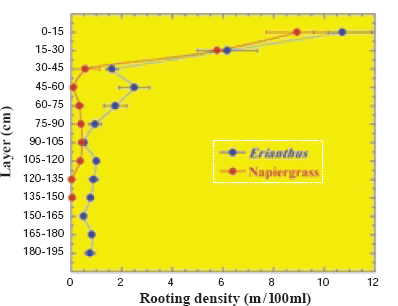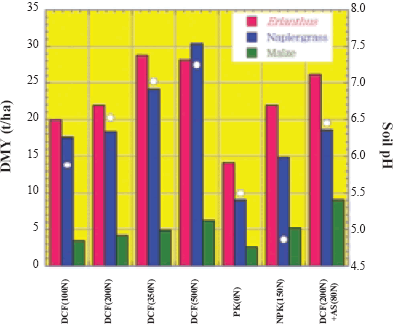Eco-physiological characteristics and yielding ability of Erianthus spp.
Description
[Objectives]
Erianthus spp. is a sugarcane relative that is found throughout the year at various sites ranging from mountainous areas to swamps and riversides in Thailand. Because of its ability to flourish in such diverse environments, its importance as a genetic resource in sugarcane breeding and as a source of roughage for livestock has achieved widespread recognition. With regard to these functions, the eco-physiological characteristics of Erianthus were studied in relation to soil moisture, and its yielding abilities were evaluated under the application of animal feces in comparison with napiergrass and maize.
[Results]
Starting in October 1999, at the beginning of the dry season, root development and the physical conditions of soil were investigated through analysis of soil profiles of neighboring Erianthus and napiergrass canopies. Irrespective of plural hardpans and waterlogged conditions, root development of Erianthus was observed in layers as deep as 250 cm, while roots of napiergrass were rarely found deeper than 135 cm in soil which was almost completely saturated with water (Fig. 1). The results of soil pF monitoring in the field showed that water loss from soil surface was minimal and considerable amounts of available water existed in the deeper soil layers even in March when there was no vegetation. Meanwhile, the results from pot experiments with adjusted ground water levels suggested that waterlogged conditions were more favorable for the biomass production of Erianthus than dry conditions, and well-developed aerenchyma were observed on the roots of plants grown under waterlogged conditions. Therefore, the drought tolerance of Erianthus can be attributed to its ability to extend its root system during the rainy season and to take up water from deeper soil layers during the dry season.
The growth and yielding abilities of three forage species including Erianthus were evaluated for two years in the field after several fertilizer treatments. The rooting and growth of Erianthus after planting were rather slow and its dry matter yield (DMY) was considerably lower than napiergrass, although higher than maize in the first year of planting. However, in the second year, Erianthus tended to show higher DMY than napiergrass in all plots excluding those which had received the highest rate of dried feces application, and the maximum DMY of Erianthus amounted to 30 t/ha after combining the yields of four harvests. In addition, Erianthus showed better yields than did napiergrass under conditions without nitrogen fertilization. There was significant reduction in the DMY of maize and napiergrass associated with the decline of soil pH caused by the annual application of ammonium sulfate, while there was no reduction in the DMY of Erianthus (Fig. 2). These results indicate the high yielding ability of Erianthus, especially under the acidic and infertile soil conditions common to Northeast Thailand.
The results detailed above suggest the high adaptability of Erianthus to the conditions prevalent in Northeast Thailand and its usefulness in sugarcane breeding and biomass production; however, it is necessary to conduct further research focusing on its practical uses as roughage for livestock.
Figure, table
-
Fig. 1. Root distribution of Erianthus spp. and napiergrass. -
Fig. 2. Dry matter yields of three forages in second year of planting.
Notes: sombol( ○ ) soil pH; DCF dried cattle feces; AS ammonium sulfare; values in parentheses indicate the amount of material in terms of nitrogen.
- Affiliation
-
Japan International Research Center for Agricultural Sciences Crop Production and Environment Division
- Classification
-
Technical A
- Term of research
-
FY2001 (FY1999-FY2001)
- Responsible researcher
-
MATSUO Kazuyuki ( Crop Production and Environment Division )
MATSUMOTO Naruo ( Crop Production and Environment Division )
CHUENPREECHA Taweesak ( Khon Kaen Animal Nutrition Research and Development Center )
- ほか
- Publication, etc.
-
- Japanese PDF
-
2001_06_A3_ja.pdf1.35 MB
- English PDF
-
2001_06_A4_en.pdf71.41 KB


